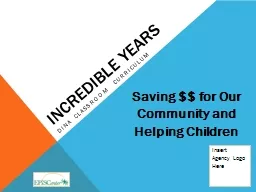PPT-Last updated April 2017 [INSERT YOUR ORGANIZATION’S NAME AND LOGO]
Author : conchita-marotz | Published Date : 2018-09-17
INSERT NAMES OF PRESENTERS How Your Child Care Program Can Support Immunization After participating in this training participants should be able to Understand
Presentation Embed Code
Download Presentation
Download Presentation The PPT/PDF document "Last updated April 2017 [INSERT YOUR ORG..." is the property of its rightful owner. Permission is granted to download and print the materials on this website for personal, non-commercial use only, and to display it on your personal computer provided you do not modify the materials and that you retain all copyright notices contained in the materials. By downloading content from our website, you accept the terms of this agreement.
Last updated April 2017 [INSERT YOUR ORGANIZATION’S NAME AND LOGO]: Transcript
Download Rules Of Document
"Last updated April 2017 [INSERT YOUR ORGANIZATION’S NAME AND LOGO]"The content belongs to its owner. You may download and print it for personal use, without modification, and keep all copyright notices. By downloading, you agree to these terms.
Related Documents

![PPT-Last updated April 2017 [INSERT YOUR ORGANIZATION’S NAME AND LOGO]](https://thumbs.docslides.com/668341/last-updated-april-2017-insert-your-organization-s-name-and-logo.jpg)












![[Insert Organization and/or Presenter Name]](https://thumbs.docslides.com/1028606/insert-organization-and-or-presenter-name.jpg)